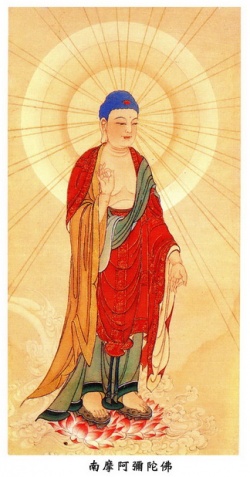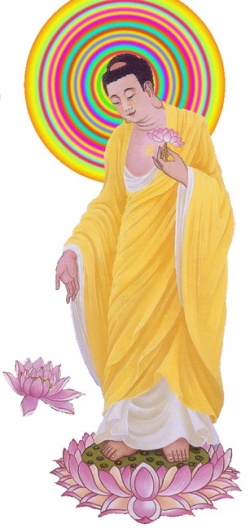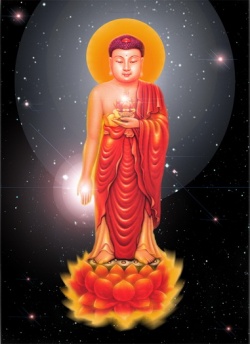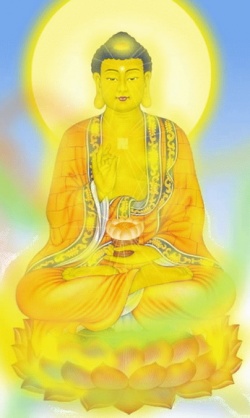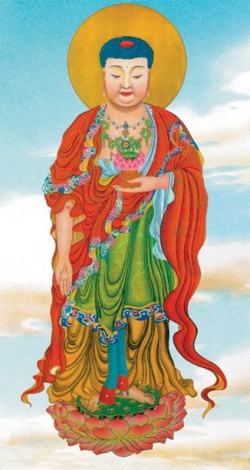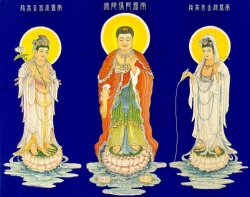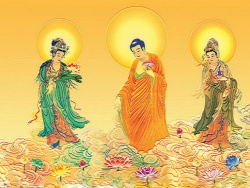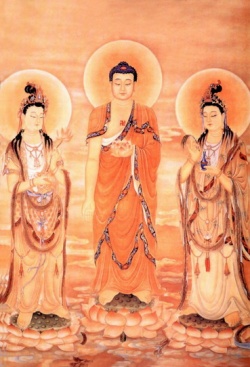Principal teachings of the true sect of Pure Land
I. HISTORY.
I. SHINRAN SHŌNIN.
During the past thirty centuries that have elapsed since the Death of Shākyamuni, his Good Law has grown into a huge tree with many outstretching branches; and each of these is now everywhere endeavoring to propound the Law according to its own way of interpretation, and also to perpetuate its own religious practice. Among these branches, the one that most clearly indicates the Blessed One's way of salvation and that most thoroughly teaches his Life of Faith is the True Sect of Pure land; for surely it is the Doctrine of this Sect that the ultimate signification of The Buddha's will to save is faithfully preserved. While it goes without saying that this True Sect of Pure land is the Doctrine preached by the World-honored Shākyamuni Buddha himself, it was not until some seven hundred years ago, that is, until the founder of the True Sect, Shinran Shōnin, stayed in the Province of Hidachi to promulgate a new Buddhist teaching, that this Sect came to be recognised as such, forming an independent organisation among the Buddhists.
Shinran Shōnin was born on April 1 in the third year of Jōan, 1173 A.D., in the village of Hino near Kyōto. His family was of the Fujiwara clan that occupied at the time the most important position in the empire, and his Noble father, Arinori Hino, held an honorable office at the imperial court. The Shōnin was the eldest son, and from this fact we can easily see what an auspicious prospect he had before him; for could not he, as heir to a Noble family, occupy a high official rank, wield his influence as he willed, and indulge in the enjoyment of a worldly Life? But the Death of his parents, while he was yet a child, made him depend upon his uncle, Lord Noritsuna; and this unfortunate circumstance left a very deep impression on his young Mind, which, naturally sensitive, now brooded over the uncertainty of human Life. At the age of nine, he left home to lead a monkish Life at a Buddhist Monastery called Shōren-in at Awada-Guchi, where Jiyen Sōjō, the high priest, took him as Disciple, shaved his head, and gave him the Buddhist name, Han-yen.
After this, the Shōnin went to the Mount Hiye, and staying at the Daijō-in which was in the Mudō-ji, pursued his study under various masters in the deep philosophy of the Tendai Sect, and disciplined himself according to its religious practices. He also sought to enlarge his Knowledge by delving into the doctrines of all the other Buddhist sects; but he was unable to reach the true way leading to a release from this World of pain. He went even so far as to invoke the aid of the gods as well as the Buddhas to make him realise an immovable state of tranquillity; but all to no purpose.
While thus vainly seeking his way of release, many years passed on; and he came to be looked up and paid high respect by all his teachers and friends as one whose deep learning and unimpeachable Morality were incomparable. His priestly rank advanced, and when he was twenty-five years old, he was made Monzeki (chief priest) of the Shōkō-in. All these successes, however, were far from satisfying his Noble spirit, which was ever hankering after the Truth. His spiritual vexations increased the more. When will the Light come to this poor yet earnest Truth-seeker?
His twenty-ninth year which he attained in the first year of Kennin (1201 A.D.), still found him in a state of Mental uncertainty. Determined to arrive at the settlement of all his doubts, he went daily to the Rokkaku-dō, Kyōto, for one hundred days beginning with Jan. 10 of that year, and offered his final prayers to Avalokitēçvara Bōdhisattva (Kwannon Bosatsu) to suffer him to see the Light. At last, he had a vision of the Bosatsu, and through his instruction he went to Yoshimidzu in order to be taught by Hōnen Shōnin. Now, according to his Doctrine, all Sentient beings were sure to be saved and embraced in the Light of Amida[1] and to be born in the Land of Happiness, eternal and imperishable, if they, however sinful, only believe in the name of The Buddha, and, forsaking all their petty cares of the World at present and to come, abandon themselves to his saving hands so mercifully extended towards all beings, and recite his name with singleness of Heart. It was through listening to this Doctrine that our Shōnin came to remove from his Mind every shadow of his spiritual Doubt. Then, for the first time, he came to perceive that Amida was the name of his true Father, and could not help realising that, during these twenty-nine years of his existence, his Life had ever been actuated by this Father's will to save, and that this true Father, from the very beginning of all things, had been unintermittently at work to save his sinful children through his eternal mercy. The Shōnin was filled with Joy and Gratitude unspeakable. To commemorate this occasion of his spiritual regeneration, he was given by his master a new Buddhist name, Shakkū. Abandoning his former adherence to the Faith of the Tendai Sect, he now embraced the Pure land Sect; that is to say, forsaking the uncertainty of "self-salvation" (Jiriki, meaning "self-Power"), he became a believer in the efficacy and surety of salvation through a Power other than his own (tariki, meaning "other-Power").
After this, he resigned his priestly position as Monzeki, and becoming a mere Buddhist monk in black, he built an humble hut at Okazaki, where he continued to receive further instructions from Hōnen Shōnin. His Faith grew ever deeper until he thoroughly understood the signification of his master's Doctrine. In October, 1203 A.D., our Shōnin decided to follow the advice of Hōnen Shōnin to enter upon a conjugal Life and to give the World an example concretely illustrating their Faith that the Householder could be saved as much as the celibate Monk. He was, therefore, married to Princess Tamahi, daughter of Prince Kanezane Kujō, formerly prime minister to the Emperor.
He was thirty-one years of age while the Princess eighteen. This marriage, in fact, was undertaken to settle the religious Doubt then prevailing as regards the final redemption of those secular householders, who, living with their family, have not completely destroyed the root of passion. Prince Kujō was one of those who were in Doubt about this point, and our Shōnin made the practical demonstration of his belief by marrying one of his daughters and living the Life of a man of the World. In the year following, a son was born to him, who was named Han-i.
In 1205 A.D., our Shōnin was given by his revered master a copy of his work entitled, "The Sen-Jyaku Hon-Gwan Nen-Butsu Shū[2] —which we have reason to consider a memorable event in the Life of Shinran Shōnin; for it was to a very selected few that the master was pleased to give his own Writing,—only to those disciples of his who distinguished themselves in learning and Virtue. Our Shōnin assumed yet another name this year in accordance with his master's wish. The name was Zenshin, meaning "good Faith." In this wise, the relation between the Shōnin and his master grew closer and closer, every one recognised in him a spirit that harbored a most powerful Faith equal to that of his master.
Fortunately or unfortunately, this fact led to a series of sad events in 1207 in the Life of the Founder of the True Sect. The beginning of it was the Conversion of two court ladies into the Faith of Pure land, who finally entered a nunnery. This greatly offended the Feeling of the court and set it against Hōnen Shōnin and his followers. Taking advantage of the court's displeasure, those Buddhist Monks belonging to the Kōfuku-ji Monastery at Nara, who were for years observing the spread of the Pure land Sect with unmitigated jealousy, now maliciously denounced its chief propagators to the court and asked for an imperial order to forbid the preaching of the Doctrine of the Pure land Sect. The court at last lent its ear to this vicious counsel and ordered Hōnen Shōnin to leave the Capital for Tosa Province. Our founder, too, as the foremost Disciple of the Venerable Hōnen, could not escape the misfortune and was banished to Kokubu in Echigo Province.
Our Shōnin had now to be separated from his revered master as well as from his beloved family. We can well understand what sorrowful feelings were then astir in his Heart, which, however, was not so darkened as to be altogether insensible to the other aspect of this sad event. Perceiving the gracious design of The Buddha even in the midst of the calamity, he Thought in this wise: "Echigo, which is so remotely situated, could perhaps never have chance to listen to the Good Law of The Buddha if there were not such an opportunity as this. My banishment serves an excellent purpose of proselytism. If I happen to find even one soul embracing the same Faith as mine in that remote province, I shall regard it as owing to the Wisdom of my Venerable master." Thus Thinking, he departed for his destination with cheerful spirits.
Therefore, all the way along his long journey, our Shōnin made use of every occasion to give utterance to his Faith and to make his people interested in the Good Law. When finally he reached his place of banishment in Echigo, he was ever active in his missionary work, going about in his neighboring villages and exercising his personal influence over The country people. In the meantime, Princess Tamahi, who, being left behind in the Capital, had spent days and nights in sorrow and without consolation, made up her Mind to share with her husband the provincial loneliness in the faraway snowy region of Echigo, and let herself suffer the misery of banishment.
Five years passed, and in November, 1211, the court issued an order to terminate the banishment of our Shōnin. The message carried by Lord Norimitsu Okazaki did not arrive at the destination until December of the same year.
To his receipt of the message, our Shōnin signed himself Gutoku (which means "simple-hearted bald man"). He inwardly wished, by thus designating himself, to determine his own status among followers of The Buddha, which was neither that of a Monk nor that of a layman,—his was indeed a most peculiar one. What other signification he wanted to give to this unique title was that he was one of those simple-hearted Buddhists who were not wise, nor intelligent, nor learned. He used to believe himself as an ignorant and sinful soul, as it implied in the literal sense of the title, Gutoku. This critical valuation of himself was an aspect of his religious belief. Afterwards, he had another name given himself, Shinran, by which he is popularly known now.
When he received the message of release, he wished at once to proceed to the Capital and see his Venerable master; but being prevented by various circumstances, it was not until January of the following year that he could start from Kokubu. When he reached Kōdzuke on his way to Kyōto toward the middle of February, an unexpected news made him plunge into the deepest sorrow and despair; for it was the news of the Death on January 25 of his revered master, Hōnen Shōnin, whom he wished to see fervently for once before his final passing. His Heart-breaking was so great, indeed, that he threw himself down on the ground and cried most piteously. He now abandoned his plan to proceed to the Capital, and making his way for Hidachi Province, he visited several towns along his route and preached his Faith to the people.
Since January, 1217, he settled at Inada of Hidachi Province, and began Writing his "Kyō-Gyō-Shin-Shō"[3] (The Teaching, Practice, Faith, and Attainment), in which are laid down the fundamental principles of the True Sect of Pure land. This was his first literary work, and the greatest, for on this is built the entire structure of the True Sect. After the passing of his master, there were many of his disciples, who failed to grasp the spirit of their master and grossly misrepresented its vital signification. To save the latter from a wreckage, therefore, and to make known the true purport of the Pure land Sect (that is, the True Sect of Pure land) free from all possible misinterpretations, he wrote this most significant book. It was completed in the year 1224, when our Shōnin was fifty-two years of age.
In the year following (1225 A.D.), the Shōnin built a temple at Takada of Shimodzuke Province. In 1226, the temple received the name, Senju Amida Ji, by an imperial order. After this, the True Sect of Pure land began to draw its circles of propagation wider and wider around these two centers, Inada and Takada; and many men and women of good family gathered about him, who led them to the Truth of the Buddhist Faith. For twenty years in these localities he had thus been indefatigably engaged for the cause of the True Sect of Pure land, when he conceived an idea to visit the Capital in 1232. He was then sixty years old.
He left his Monastery at Takada to the care of his Disciple, Shimbutsu; and accompanied only by two of his disciples, (while his wife remained alone at Inada,) he started for Kyōto where he had been long absent. In Kyōto he had no fixed residence, and moved from one place to another, among which we may mention Gojō-Nishinotōin, Okazaki, Nijō-Tominokōji, etc. He was never tired of preaching the Good Law of the compassionate Buddha to whomever that came to him for spiritual guidance and helpful instructions; and to those who could not pay him a personal visit, he sent letters dwelling upon the joyful Life of a devout Buddhist. Towards the end of his Life the Shōnin wrote various messages for the sake of uneducated followers of his Faith, in which he expounded the essentials of the True Sect in the plainest possible terms.
In 1262, he reached the high age of ninety, and began to show symptoms of an illness on November 23; but he complained of nothing particularly, except speaking of the deep Love of Amida and reciting his name with profound devotion. On the twenty-seventh, he bid farewell to his disciples, saying that he would be waiting for them in Pure land when the time come for them to join him there. After this, he kept on reciting the name of Amida. On the following day, according to the example shown by the Great Muni of the Shākyas at the time of his Nirvāna, he had his head turned towards the North, facing the West, and lying on his right-hand side, in a room at the Zembō-in; at noon his reciting came quietly to an end, showing that he finally returned to the Land of Light, when it is said that an odor of indescribably sweet fragrance filled the room and a flash of white Light was seen across the Western sky, as if unfolding a long piece of immaculate linen.
His remains were cremated on the twenty-ninth at the Yennin-ji, south of Toribeno, and his ashes were buried at Ōtani, Higashiyama, over which now stands tombstones.
The Shōnin was apparently a manifestation of Amida-Butsu, he was indeed a saving Light who came among us some seven hundred years ago to dispel the darkness of this World. His Life of ninety years on earth was an imprint eternally engraved on the hearts of sinners not yet freed from impurities. He lived among us to typify the Life of a sinful soul, who could yet be saved through his Faith in the boundless Love of Amida, and left a unique example for us who are intoxicated with the wine of passion. So, our Shōnin did not follow the steps of an ancient sage, who, leaving his home and severing all the family tics, would fly away from this World, in order to cleanse the Heart, to sanctify the conduct, and to be thoroughly imbued with the purest religious sentiment, and who by Virtue of these unworldly merits was permitted to be born in The country of The Buddha. The Shōnin, on the contrary, married Princess Tamahi and lived a family Life, even after his confirmation in the Buddhist Faith.
Four sons and three daughters were born through this union. The first, third, fourth, and fifth children were sons who were named respectively, Han-i, Zenran, Myōshin, and Dōshō; while the second, sixth, and seventh were daughters, whose names were: Masa-hime, Saga-hime, and Iya-hime. The Shōnin could not help but deeply Love these children, so dear to the Heart of the father that he once confessed with a truly human weakness: "I am the one who, not knowing how to be blessed by the saving Love of Amida, is drowned in the tempest of passion and has lost his way in the mountains of worldliness." The founder of the True Sect, thus unlike most religious leaders, was a husband and father, who loved his family with all his Heart and found his salvation in the eternal Love of Amida.
It is due to this fact that in the True Sect of Pure land there is no distinction made between the Monk and the layman as regards their outward religious practice; while in all the other Buddhist sects the Monk leads a Life of Celibacy and refrains from eating the animal's flesh, the followers of the True Sect have no such special order among them, for their "Monks" marry and eat meat. Their religious Life, therefore, consists in continuing to live an ordinary, everyday human Life, not necessarily struggling to free themselves from the so-called "Defilements" of the flesh, and in leaving the grave matter of salvation entirely in the saving hands of Amida; for theirs is only to be grateful for The Buddha's saving Love and to express this Gratitude by the observance of all the Moral laws and the efficient execution of their respective duties. This Faith and this way of living were exemplified by our Venerable Shinran Shōnin, the Founder of the True Sect of Pure land.
The Shōnin had many devoted disciples, among whom the following were the most noted: Shōshin, Shimbutsu, Jun-shin, Muyishin, Myōhō, Yuiyen, Nyūsai, Saibutsu, Kakushin, Ren-yi, etc. There were among these disciples some who had at first entertained an idea to murder the master, imagining him to be the enemy of Buddhism; but as soon as they approached the Shōnin, his personality so powerfully impressed them that they at once abandoned the Evil design and became the most devoted of his disciples. There were, again, others who grew more attached to the master, because he was revealed to them in a vision as an incarnation of Amida. It is not, therefore, difficult for one to realise even in these remote days with what veneration he was regarded by these people; indeed, who could refrain from revering him as a Buddha? In spite of these facts, the Shōnin refused to regard these devoted followers of his as disciples, but considered them as his best friends embracing the same Faith, or as his younger brothers growing under the guidance of the one spiritual father. He respected and loved every one of them as such, declaring: "I, Shinran, have no disciples in Faith." It is evident then that the master entertained no Thought of styling himself as a religious leader or teacher, he only regarded himself as a blessed child living in the all-embracing Love of Amida.
In his old age, he wrote many Books, in which he praised the Love and Virtue of The Buddha, confessed his Faith, and propounded the principles of the True Sect of Pure land; and it is through these writings that we have now access to the inner Life of our Founder. Among chief works of his besides the one already referred to, "The Kyō-gyō-shin-shō," we mention the following: "The Gutoku-shō," [4] "The Jōdo-monrui-jushō,"[5] "The Nyū-shutsu-nimon-ge,"[6] "The Jōdo-sangyō-wōjō-monrui,"[7] "The Wōgen-yekō-monrui,"[8] "The Jōdo-wasan,"[9] "The Kōsō-wasan,"[10] "The Shōzōmatsu-wasan,"[11] "The Yui-shin-shō-mon-i,"[12] "The Songō-shinzō-meimon,"[13] "The Ichinen-tanen-shōmon,"[14] etc.
Besides these, we have two volumes of his letters collected by his disciples, which are entitled, "The Mattō-shō"[15] and "The Go-shōsoku-shū."[16] Still later, Nyoshin Shōnin, grandson of the master, compiled sayings of the latter under the title, "The Tan-i-shō."[17] By the aid of these Books, we are able to look into his Faith and conviction as it was alive in his Heart; and our exposition of the Doctrine of the True Sect will be according to these works.
Footnotes
- ↑ "Amida" in Sanskrit, and "Omitho" in Chinese.
- ↑ A collection of those passages from the sūtras and other works with their explanation, which relate to the thinking of the Buddha (nembutsu) or the reciting of his name,—this reciting being Amida's original prayer (hongwan) most thoughtfully selected by himself.
- ↑ An exposition of the essential principles of the True Sect as to what it teaches (kyō), practises (gyō), believes (shin), and attains (shō). 6 fasciculi.
- ↑ Literally, "the simple-hearted bald man's copy-book." This is the name given by Shinran Shōnin to his own writing in which he declares his religious faith as a simple-hearted monk. By "bald" is meant a shaved head. 2 fasiculi.
- ↑ A book in which such passages in the sūtras as relate to the Pure Land doctrine are systematically collected.
- ↑ "Stanzas concerning the two gates, entrance and exit" The entrance is to enter into Pure Land, and the exit means coming back from Pure Land to this world of defilement in order to save one's fellow-beings.
- ↑ Such passages collected from the sūtras of the Pure Land doctrine, and compared, as relating to the birth in Pure Land.
- ↑ A classified collection of those passages which relate to the Buddha's grace towards us in its twofold operation, going and coming back. The going means being born in Pure Land, and the coming back is re-appearance in this world.
- ↑ Hymns of Pure Land in easy Japanese.
- ↑ Hymns in easy Japanese dedicated to the Seven Great Fathers of the True Sect.
- ↑ Hymns concerning the three periods of religion, orthodox, representative, and terminating. in which it is explained that for us born in the terminating period the True Sect is the most appropriate religion.
- ↑ A commentary work on the venerable Seikaku's book on faith, in which is set forth the doctrine of salvation by faith alone.
- ↑ The scriptural passages explained which are inscribed on the paper bearing the honorable names of the Buddha as well as the portraits of the Fathers.
- ↑ "My view concerning the controversy between the One Thought and the Many Thoughts."
- ↑ "The Light of the Terminating Period." A book in which are collected some of Shinran's sayings and letters.
- ↑ "Letters of the Venerable Shinran."
- ↑ A work written with a view to settle the heterodoxical opinions that were entertained by some True Sect followers concerning the real signification of the teaching of Shinran.

